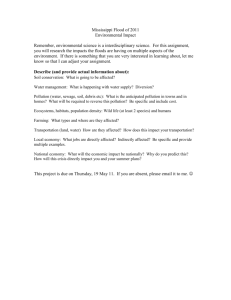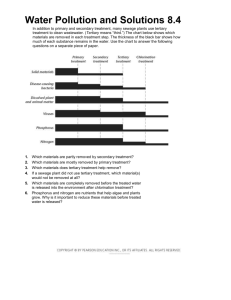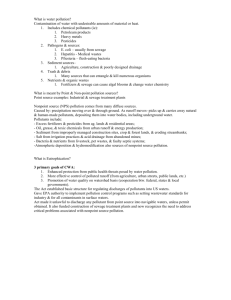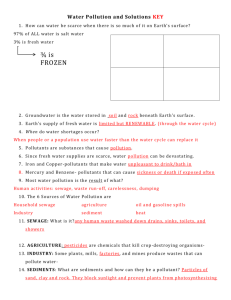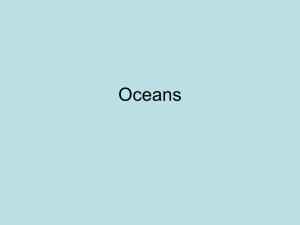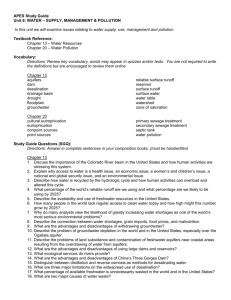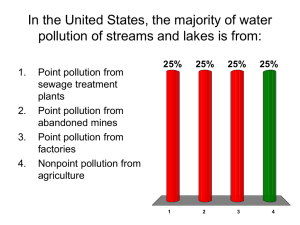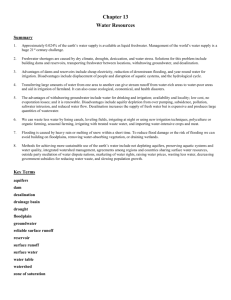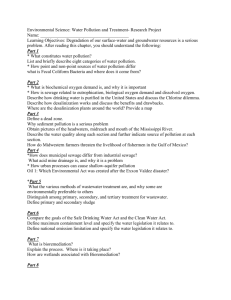Water Quality Notes - CynthiaJankowski
advertisement
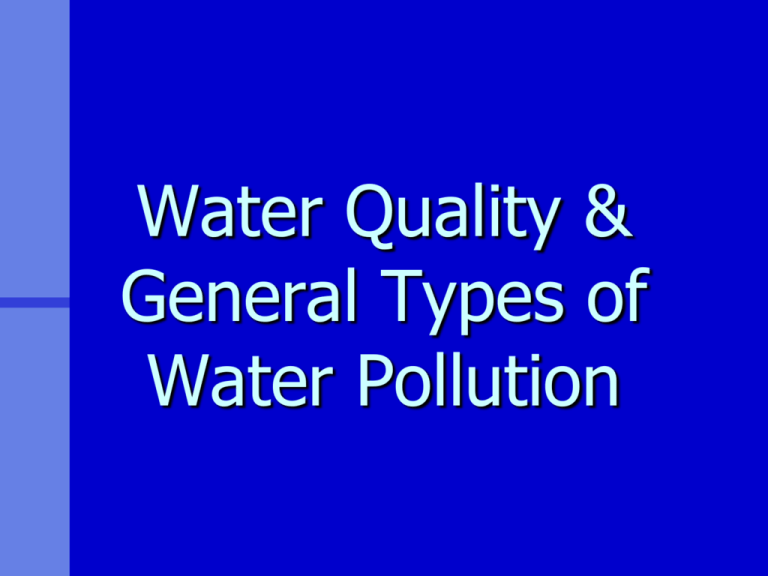
Water Quality & General Types of Water Pollution Most of the Earth’s Freshwater Is Not Available to Us Water covers 71% of earth’s surface Freshwater availability – 0.024% Groundwater, lakes, rivers, and streams Hydrologic cycle Movement of water in the seas, land, and air Driven by solar energy and gravity Distributed unevenly Humans can alter the hydrologic cycle Withdrawing water, polluting, climate change Water Usage Irrigation (70%)– watering crops Industry (20%)– coolant (power plant) Domestic and Municipal (10%)– drinking, sewage, bathwater, dishwater & laundry Virtual water Not consumed; used to produce food and other products Fig. 13-6, p. 322 Case Study: Freshwater Resources in the United States Freshwater supplies are not evenly distributed, and one of every six people on the planet does not have adequate access to clean water We are using available freshwater unsustainably by wasting it, polluting it, and underpricing what is an irreplaceable natural resource Effects our misuse are Floods, Drought, and Pollution TOO MUCH WATER Problems include flooding, pollution of water supply, and sewage seeping into ground. Heavy rainfall, rapid snowmelt, removal of vegetation, and destruction of wetlands cause flooding. Floodplains, which include wetlands, help provide natural flood and erosion control, maintain high water quality, and recharge groundwater. To minimize floods, rivers have been narrowed with levees and walls, and dammed to store water. TOO MUCH WATER Tree plantation Diverse ecological habitat Evapotranspiration Trees reduce soil erosion from heavy rain and wind Roads destabilize hillsides Agricultural land Tree roots stabilize soil Vegetation releases water slowly and reduces flooding Forested Hillside Evapotranspiration decreases Overgrazing accelerates soil erosion by water and wind Winds remove fragile topsoil Agricultural land is flooded and silted up Gullies and landslides Heavy rain erodes topsoil Silt from erosion fills rivers and reservoirs Rapid runoff causes flooding After Deforestation Stepped Art Fig. 13-29, p. 343 Too Little Water Examples include drought and expanding deserts (desertification). Groundwater / Aquifer Depletion Most aquifers are renewable Unless water is contaminated or removed Aquifers provide drinking water for half the world Water tables are falling in many parts of the world, primarily from crop irrigation Groundwater used to supply cities and grow food is being pumped from aquifers in some areas faster than it is renewed by precipitation Groundwater & Aquifers Ogallala Aquifer Groundwater or aquifers are water recharge areas that are located beneath the ground surface in soil pore spaces and fractures in the Earth’s formations. Natural discharge occurs from springs and wetlands. The water table measures the level of Earth’s land crust to which the aquifer is filled or the division between saturated and unsaturated rock. Renewability rates of aquifers differ depending on the surrounding conditions of the land and the water cycle. The circulation rate of most aquifers is usually slow (300 to 4,600 years) compared to the rate they are being depleted. Ground Water Problems Ground water problems include pollution, increase in salinity, and draining too much. Sinkholes can form when the roof of an underground cavern collapses from draining too much water. Harms both humans and endangers many species. Case Study: Overpumping the Ogallala Ogallala aquifer – largest known aquifer Extends from South Dakota to Texas Irrigates the Great Plains Very slow recharge Water table dropping Water pumped 10-40 times faster than recharge Government subsidies to continue farming deplete the aquifer further Biodiversity threatened in some areas Northern states will still have ample supplies, but for the south it’s getting thinner. Groundwater Depletion: A Growing Problem Areas of greatest aquifer depletion from groundwater overdraft in the continental U.S. The Ogallala, the world’s largest aquifer, is most of the red area in the center (Midwest). Figure 13-5 Population Growth Problems include over-drawing fresh water, pollution, and overbuilding so that water can’t seep into the ground. Sharing Water Resources There are water wars out west. California bought the water from the Colorado River, but Arizona wants it. Who owns it? The same thing is happening in Texas. More water rights are sold than the actual amount of water. How do you share water? This is a problem all over the world. U.S. Geological Survey projection, 2007: Water hotspots Washington Montana Oregon Idaho Wyoming By 2025, areas around world could face intense conflicts over scarce water Nevada North Dakota South Dakota Nebraska Utah Colorado California Kansas Oklahoma Arizona New Mexico Texas Highly likely conflict potential Substantial conflict potential Moderate conflict potential Unmet rural water needs Fig. 13-8, p. 323 Overdrawing Surface Water Case Study- Aral Sea The Aral Sea has been greatly affected by water diversion projects for irrigation and this has caused lake water levels to drop. This has created a major ecological, economic, and health disaster.(read pg. 332) Effects of the dropping sea level : Water has dropped 22 meters since 1961 The sea’s salinity has tripled 20 of the 24 native fish species have gone extinct. About 85% of wetlands have been eliminated and 50% of local bird and mammal species have disappeared. 1989 2008 2012 Stable Runoff As water runs off from rain, it’s supposed to get into rivers, and finally off to the sea. But when we dam rivers, less goes to the ocean, meaning the brackish water (where the river hits the ocean) becomes more salty. This is the breeding ground for many fish and invertebrates. This harms the ecology of the area. Salinization of Irrigated Soil Water is poured onto soil and evaporates. Over time, as this is repeated, nothing will grow there anymore. Impacts of Human Activities on Freshwater Systems Dams, cities, farmlands, and filled-in wetlands alter and degrade freshwater habitats. Dams, diversions and canals have fragmented about 40% of the world’s 237 large rivers. Flood control levees and dikes alter and destroy aquatic habitats. Cities and farmlands add pollutants and excess plant nutrients to streams and rivers. Many inland wetlands have been drained or filled for agriculture or (sub)urban development. Water Management Dams and Reservoirs •Description: A dammed stream that can capture & store water from rain & melted snow. •Benefits: Hydroelectric power; provides water to towns; recreation; controls floods downstream • Problems: Reduces downstream flow; prevents water from reaching the sea (Colorado River) devastates fish life; reduces biodiversity. USING DAMS AND RESERVOIRS TO SUPPLY MORE WATER Large dams and reservoirs can produce cheap electricity, reduce downstream flooding, and provide year-round water for irrigating cropland, but they also displace people and disrupt aquatic systems. Provides water for year-round irrigation of cropland Provides water for drinking Reservoir is useful for recreation and fishing Can produce cheap electricity (hydropower) Downstream flooding is reduced Flooded land destroys forests or cropland and displaces people Large losses of water through evaporation Downstream cropland and estuaries are deprived of nutrient-rich silt Risk of failure and devastating downstream flooding Migration and spawning of some fish are disrupted Fig. 13-13a, p. 328 Powerlines Reservoir Dam Intake Powerhouse Turbine Fig. 13-13a, p. 328 Case Study: Colorado River Issues The Colorado River has so many dams and withdrawals that it often does not reach the ocean. Has 14 major dams , reservoirs, and canals. Flows through seven states and two countries, with much of its course through desert. Large quantities of water removed from it every year to reservoirs in other parts of the country. Many endangered species live in or along the course of the river. Lake Powell, is the second largest reservoir in the U.S. Colorado River Issues Glen Canyon Dam Advantages of a river’s use are: provides water for more than 24 million people irrigates 2 million acres of land provides major tourist attractions provides 4,000 MW of electricity Disadvantages of a river’s use are: lowered water quality river delta affected by low water flows loss of habitat for many animals major construction and diversion issues Aswan High Dam Two dams straddle the Nile River at Aswan, Egypt. Completed in 1970 and formed Lake Nasser which is 550 km long and capable of holding two years of the Nile's annual flow. The main objectives of the project were: energy generation in a renewable form. flood control in downstream locations. provision of water for agriculture and domestic use. A serious detrimental effect is the loss of the annual floods downstream. These used to replenish the nutrients of the flood plain and flush out accumulated salts. Wiki Commons Aswan High Dam ‣ Without flooding, fertilizers must be applied to the land and salts build up in the soils, causing crops to fail. ‣ Without annual deposition of river sediments because of buildup behind the dam, the land is eroding, allowing the sea to encroach up the river delta. ‣ Damming has also caused 64% of commercially fished species in the Nile to disappear. ‣ Time will tell if better management will help to reverse the Photo: NASA problems currently being experienced in the Nile Delta region. Photo: Guuganji Creative Commons Attribution ShareAlike 3.0 Spans the Yangtze River at Sandouping, China, and is the largest hydroelectric dam in the world, capable of producing 22,500MW of electricity. (equal to 18 large coal burning plants or nuclear power plants) Major construction began in 1994 and was completed by 2012. Debate over whether advantages will out way disadvantages. Creative Commons Attribution ShareAlike 3.0 Photo: Christoph FlinkoBl Three Gorges Dam Three Gorges Dam Issues Advantages of construction: reduction of coal use in coal fired power stations flood control downstream drought relief Photo: BS Thurner Hof Creative Commons Attribution ShareAlike 3.0 better navigation of the river by ships Disadvantages of construction: submergence of wetlands and agricultural lands loss of endangered plant and animal habitats archaeological sites flooded upstream The critically endangered Siberian crane uses wetlands for winter feeding that will be flooded by the Three Gorges Dam. towns and cities flooded and 1.2 million people displaced Built over seismatic fault and already has small cracks. Dam Removal Some dams are being removed for ecological reasons and because they have outlived their usefulness. In 1998 the U.S. Army Corps of Engineers announced that it would no longer build large dams and diversion projects in the U.S. The Federal Energy Regulatory Commission has approved the removal of nearly 500 dams. Removing dams can reestablish ecosystems, but can also re-release toxicants into the environment. Water Diversion •Description: Damming a river to control where the water flows •Benefits: Keeps water where we want it- cities! •Problems: Drains wetlands, destroys land Desalinization •Description: Removing salt from salt water •Benefits: Freshwater •Problems: Uses lots of energy; costs 3-5X’s more money; what do we do with the salt? DESALTING SEAWATER Removing salt from seawater by current methods is expensive and produces large amounts of salty wastewater that must be disposed of safely. Distillation: heating saltwater until it evaporates, leaves behind water in solid form. Reverse osmosis: uses high pressure to force saltwater through a membrane filter. SEEDING CLOUDS, AND TOWING ICEBERGS AND GIANT BAGGIES Seeding clouds with tiny particles of chemicals to increase rainfall, towing icebergs or huge bags filled with freshwater to dry coastal areas have all been proposed but are unlikely to provide significant amounts of freshwater. Harvesting Icebergs •Description: Towing massive icebergs to arid coastal areas (S. California; Saudi Arabia) •Benefits: freshwater •Problems: Technology not available; costs too high; raise temperatures around the earth. INCREASING WATER SUPPLIES BY WASTING LESS WATER Sixty percent of world’s irrigation water is currently wasted, but improved irrigation techniques could cut this waste to 5-20%. Drip Method – delivers water directly to root. 90-95% efficient. Center-pivot, low pressure sprinklers sprays water directly onto crop. 80% of water reaches crop. Has reduced depletion of Ogallala aquifer in Texas High Plains by 30%. Drip irrigation (efficiency 90–95%) Gravity flow (efficiency 60% and 80% with surge valves) Center pivot (efficiency 80%–95%) Water usually comes from an aqueduct system or a nearby river. Above- or belowground pipes or tubes deliver water to individual plant roots. Water usually pumped from underground and sprayed from mobile boom with sprinklers. Conservation Using less water or saving the water we have Industry Recycle water Irrigation Surge flow (gravity) Drip irrigation $$ Municipal uses Incentives and regulations limiting water use Gray water Benefits: Saves money and wildlife Problems: bothersome to people; lack of caring; laziness Pollution WATER POLLUTION: SOURCES, TYPES, AND EFFECTS Water pollution is any chemical, biological, or physical change in water quality that has a harmful effect on living organisms or makes water unsuitable for desired uses. Point source: specific location such as a factory or sewage treatment plant (drain pipes, ditches, sewer lines). Nonpoint source: cannot be traced to a single site of discharge (atmospheric deposition, agricultural / industrial / residential runoff) Point and Nonpoint Sources of Pollution Sources of Pollution Agriculture Fertilizers, pesticides,animal wastes, sediment eroded from the land Municipal Waste Sewage, fertilizers, dumping into drainage ditches, etc. Industrial Waste Chemicals left over from manufacturing, waste products, etc. Mining Erosion and toxic chemicals Types of Water Pollutants Inorganic Wastes Organic Wastes Sediments Thermal Radioactive Pathogens In the Ganges River in India the people drink, wash clothes and use the restroom all in the same water. Inorganic Compounds Mineral, not biological, in origin. Contaminants that contain elements other than carbon. Ex. include acids, salts, and heavy metals like mercury and lead. Many find their way into both surface water and groundwater from sources such as industries, mines, irrigation runoff, oil drilling and urban runoff from storm sewers. Inorganic Compounds Causes Nitrates and phosphates come from sources such as human and animal wastes, plant residues, atmospheric deposition and residential land. Environmental Effects Some of these inorganic pollutants are toxic to aquatic organisms. Bioaccumulation, biomagnification Health Effects Lead and mercury are poisonous. Mercury exposure to developing fetuses in pregnant women has been linked to a variety of conditions such as mental retardations, cerebral palsy, and developing delays, causes kidney disorders and several damage the nervous and cardiovascular systems. Low levels of mercury in the brain cause neurological problems such as headache, depression, and quarrelsome behavior. Plant and Algal Nutrients Chemicals such as nitrogen and phosphorus that stimulate the growth of plants and algae. Known as eutrophication. Eutrophication Definition The enrichment of a lake or pond by inorganic plant and algal nutrients such as phosphorus. Because this gets into our water supply from runoff, etc., and is something that is not normally in the water, it is considered pollution. Eutrophication Cause/Effect Fertilizers, erosion, sewage, etc. get into water and the effect is high photosynthetic productivity. Environmental Effects Excess nutrients encourage excessive growth of algal and aquatic plants. This causes problems, including enrichment and bad odor. (Dead Zone or hypoxia) water is cloudy and has layer of algae and cyanobacteria. Area of ocean/sea in which the oxygen has been depleted to the point that most animals and bacteria cannot survive. Caused by runoff of chemicals and animal/human wastes Low oxygen conditions Hypoxia No oxygen conditions Anoxia Natural Vs. Cultural Eutrophication Eutrophication natural aquatic succession of nutrient enrichment, mostly from runoff of plant nutrients from the surrounding land. occurs over several hundred years Cultural eutrophication drive by human activities occurs rapidly 85% of large lakes near major population centers in the U.S. have some degree of cultural eutrophication. Organic Compounds Definition Chemicals that contain carbon. Most found in water are synthetic chemicals. Causes Produced by human activities; these included pesticides, solvents, detergents, gas, industrial chemicals and plastics, and seepage from landfills. Organic Compounds Health Effects Hundreds of synthetic organic compounds are toxic and some of these have been shown to cause cancer or birth defects. Environmental Effects Seeps into ground/surface waters from land fills Leaches into ground from runoff Sediment Pollution Definition Excessive amounts of suspended soil particles that eventually settle out and accumulate on the bottom of a body of water. (Turbidity) Causes Erosion of agricultural lands, forest soils exposed by logging, degraded stream banks, overgrazed rangelands, strip mines, and construction. Environmental Effects Reduces light penetration, covering aquatic organisms, bringing insoluble toxic pollutants into the water, and filling in waterways. Health Effects Sediments adversely affect water quality by carrying toxic chemicals. The sediment particles provide surface area to which some insoluble, toxic compounds adhere; when the sediments enter the water, so do toxic chemicals. Disease-causing agents can also be transported into water via sediments. Radioactive Substances Contains atoms of unstable isotopes that spontaneously emit radiation such as uranium, plutonium and thorium Radioactive Substances Causes Get into water from mining and processing of radioactive minerals, nuclear weapons industry, or medical/scientific research. Environmental Effects Pollutes air, water and soil. Health Effects Mutations, birth defects, mental retardation, genetic disease, leukemia, cancer (breast, bone, thyroid, skin, lung), burns, cataracts, male sterility. Thermal Pollution Definition Unnatural heating of water changing the ambient temperature Causes When heated water produced during certain industrial processes is released into waterways. Environmental Effects Decomposition of wastes occurs faster, depleting the water of oxygen; this affects aquatic life. Thermal Pollution / Dissolved Oxygen Health Effects Typically affects animals, not humans. Water quality and dissolved oxygen (DO) content in parts per million (ppm) at 20°C. Only a few fish species can survive in water less than 4ppm at 20°C. Pollution of Freshwater Streams Flowing streams can recover from a moderate level of degradable water pollutants if they are not overloaded and their flows are not reduced. In a flowing stream, the breakdown of degradable wastes by bacteria depletes DO and creates and oxygen sag curve. This reduces or eliminates populations of organisms with high oxygen requirements. Water Pollution Problems: Streams Dilution and decay of degradable, oxygendemanding wastes and heat in a stream. Pollution of Freshwater Streams Most developed countries have sharply reduced point-source pollution but toxic chemicals and pollution from nonpoint sources are still a problem. Stream pollution from discharges of untreated sewage and industrial wastes is a major problem in developing countries. Pollution of Freshwater Lakes Dilution of pollutants in lakes is less effective than in most streams because most lake water is not mixed well and has little flow. Lakes and reservoirs are often stratified and undergo little mixing. Low flow makes them susceptible to runoff. Various human activities can overload lakes with plant nutrients, which decrease DO and kill some aquatic species. Ocean Pollution North Pacific Garbage Patch Two rotating gyres On or just beneath the water surface Tiny plastic pieces harmful to wildlife Crude and refined petroleum Highly disruptive pollutants Largest source of ocean oil pollution Urban and industrial runoff from land Oil Spills When a tanker accident happens, it gets lots of publicity. EX. 1989 – Exxon Valdez, oil tanker But, more oil is released by normal operation of offshore wells, washing tankers & from pipeline or storage tank leaks. EX. 2010 – BP Deepwater Horizon in the Gulf of Mexico Estimated that oil companies spill, leak, or waste per year an amount of oil equal to that shipped by 1000 huge Exxon Valdez tankers. Floating Oil Oil coats the feathers of birds (especially diving birds) and the fur of marine animals, destroying the animals’ natural insulation and buoyancy Many drown or die of exposure from loss of body heat. Heavy oil components sink Affect the bottom dwellers Other Information Oil is broken down by bacteria over time; slower in cold waters. Heavy oil components can smother bottomdwelling organisms such as crabs, oysters, mussels, and clams, or make them unfit to eat. Oil spills have killed coral reefs. A recent study showed that diesel oil becomes more toxic to marine life with the passage of time. Methods of Clean Mechanical Floating booms contain the oil spill or keep it from reaching sensitive areas Skimmer boats are used to vacuum up some of the oil into collection barges Absorbent pads or large feather-filled pillows are used to soak up oil on beaches or in waters that are too shallow for skimmer boats Chemical Coagulating agents cause floating oil to clump together for easier pickup or sink to the bottom, where it usually does less harm. Dispersing agents break up oil slicks. However, these can also damage some types of organisms. Fire can also burn off floating oil, but crude oil is hard to ignite. Case Study: The BP Deepwater Horizon Oil-Rig Spill Spill from deep-sea oil drilling – 1 mile deep Released 4.9 million barrels of crude oil Contaminated vast areas of coastline Caused by equipment failure and poor decisions Government developed new standards for offshore drilling procedures Drinking Water Problems Sewage Causes Release of waste water from drains or sewers (toilets, washing machines, and showers) and include human wastes, soaps and detergents Environmental Effects Enrichment – the fertilization of a body of water, caused by the presence of high levels of plants and algal nutrients like nitrogen and phosphorus Sewage Health Effects Oxygen – dissolved oxygen is needed by organisms, like fish, but when sewage enters an aquatic ecosystem, the micro-organisms bloom, leaving less oxygen for the fish, etc., and then they die Sewage carries diseasecausing agents. Coliform Bacteria The W.H.O. recommends there be zero colonies of bacteria per 100ml of drinking water and 200 colonies per 100ml of swimming water. Average human excretes 2 billion organisms per day. These are organic wastes that can be decomposed by aerobic bacteria (causes lack of oxygen). Fish die as a result of a lack of oxygen Disease-Causing Agents Causes Comes from the wastes of infected individuals. Environmental Effects Municipal wastewater contains bacteria, viruses, protozoa, parasitic worms, and other infectious agents that cause human or animal diseases. Health Effects Typhoid, cholera, bacterial dysentery, polio and infectious hepatitis are some of the more common bacteria or viruses that are transmitted through contaminated food and water. An estimated 1.6 million people die every year, mostly under the age of five Table 21-2, p. 495 Global Outlook: Stream Pollution in Developing Countries Half of the world’s 500 major rivers are polluted by untreated sewage or industrial waste. Many China's rivers are greenish black from uncontrolled pollution by thousands of factories. Case Study: India’s Ganges River: Religion, Poverty, and Health Religious beliefs, cultural traditions, poverty, and a large population interact to cause severe pollution of the Ganges River in India. Very little of the sewage is treated. Hindu believe in cremating the dead to free the soul and throwing the ashes in the holy Ganges. Some are too poor to afford the wood to fully cremate. Decomposing bodies promote disease and depletes DO. Case Study: India’s Ganges River: Religion, Poverty, and Health Daily, more than 1 million Hindus in India bathe, drink from, or carry out religious ceremonies in the highly polluted Ganges River. Figure 21-6 Pollution in Great Lakes and Mississippi Mississippi and Great Lakes polluted Raw sewage and biological pollution Nonpoint runoff of pesticides and fertilizers Atmospheric deposition of pesticides and Hg 1972 – Canada and the United States Great Lakes pollution control program Decreased industrial wastes and banned phosphate containing household products. Decreased algal blooms Increased dissolved oxygen and fishing catches Better sewage treatment plants How Can We Deal with Water Pollution? Reducing water pollution requires that we: Prevent it Work with nature to treat sewage Use natural resources far more efficiently Reduce flow of pollution from land Land-use Air pollution Linked to energy and climate policy Controlling Sources of Pollution Point Sources Ban phosphate detergents Sewage-treatment improvements Nonpoint Sources Difficult to address runoff pollutants Urban Agricultural fields Deforested woodlands Overgrazed pastures Best Management Practices (BMP) SEWAGE TREATMENT Reducing Water Pollution through Sewage Treatment Septic tanks and various levels of sewage treatment can reduce pointsource water pollution. Figure 21-15 Sewage Treatment Raw sewage reaching a municipal sewage treatment plant typically undergoes: Primary sewage treatment: a physical process that uses screens and a grit tank to remove large floating objects and allows settling. Secondary sewage treatment: a biological process in which aerobic bacteria remove as much as 90% of dissolved and biodegradable, oxygen demanding organic wastes. Tertiary sewage treatment: a mixture of processes that includes chlorine disinfection Water Treatment Primary Removes suspended and floating particles, such as sand and silt, by mechanical processes such as screening and gravitational settling. The solid material that is settled out is called primary sludge. Bar screens, grit chambers, primary clarifiers, digesters and pre-aeration Secondary Uses microorganisms to decompose the suspended organic material in wastewater. Ex. trickling filters – where wastewater trickles through aerated rock beds that contain bacteria and other microorganisms, which degrade the organic material in the water. Secondary (Cont.) Or activated sludge process – wastewater is aerated and circulated through bacteria-rich particles; the bacteria degrade suspended organic material. After several hours, the particles and microorganisms are allowed to settle out, forming secondary sludge. Use aeration basins, settling tanks and sand filters Tertiary Water Treatment This includes a variety of biological, chemical and physical processes used to remove phosphorus and nitrogen, the nutrients most commonly associated with enrichment. Tertiary treatment can also be used to purify wastewater so that it can be reused in communities where water is scarce. Use chlorine as a disinfection and then chlorine is removed by SO2 so it can be released into river. Ozone (O3) is also used but leaves no residual disinfectant. UV light does the same. Reducing Water Pollution through Sewage Treatment Primary Bar screen Grit chamber Raw sewage from sewers Secondary Settling tank Aeration tank Settling tank Sludge Activated sludge Chlorine disinfection tank To river, lake, or ocean (kills bacteria) Air pump Sludge digester Sludge drying bed Disposed of in landfill or ocean or applied to cropland, pasture, or rangeland Fig. 20-24, p. 566 Reducing Water Pollution through Sewage Treatment Sewage sludge can be used as a soil conditioner but this can cause health problems if it contains infectious bacteria and toxic chemicals. Preventing toxic chemicals from reaching sewage treatment plants would eliminate such chemicals from the sludge and water discharged from such plants. However, most sewage treatment plants are not designed to remove pharmaceuticals Reducing Water Pollution through Sewage Treatment Natural and artificial wetlands and other ecological systems can be used to treat sewage. California created a 65 hectare wetland near Humboldt Bay that acts as a natural wastewater treatment plant for the town of 16,000 people. The project cost less than half of the estimated price of a conventional treatment plant. Core Case Study: Using Nature to Purify Sewage Ecological wastewater purification by a living machine. Uses the sun and a series of tanks containing plants, snails, zooplankton, crayfish, and fish (that can be eaten or sold for bait). Pollution Prevention Water monitoring Analytical technology Leak detection systems Contained storage systems Regulation Enforcement Water Quality: United States Groundwater contamination still occurs, especially due to non-point source pollution, but laws like the Safe Drinking Water Act, Clean Water Act, and Water Quality Act have helped in the U.S. Water Quality: Global Problems According to the World Health Organization, an estimated 1.4 billion people still do not have access to adequate sanitation systems. Worldwide, at least 250 million cases of water-related illnesses occur each year, with 5 million or more of these resulting in death. Specific Water Quality Measures Dissolved Oxygen The amount of oxygen gas dissolved in a given volume of water at a particular temperature and pressure. Carbon Dioxide Enters aquatic systems from the atmosphere and from respiration by animals. The concentration of CO2 varies at different depths because of light/photosynthesis. Water Quality Measures Nitrate Contaminates shallow groundwater (100 feet or less) and usually comes from fertilizers. A concern in rural areas where 80-90% of the residents use shallow groundwater for drinking. Harms humans because it reduces the blood’s ability to transport oxygen. Sulfate Problem because too much can kill fish. Gets in water from industrial processes and mining. Water Quality Measures Iron Causes problems because it separates out of the water and forms particulates (sediment), it tastes bad if it gets in our water, and can coat fish’s gills. Groundwater problems in wells, from natural minerals in rocks. Phosphate Plant nutrients that cause algae blooms. It comes from detergents, human wastes and fertilizers. Water Quality Measures Coliform General group of bacteria from animal wastes. It uses up available oxygen. Also causes e-coli disease. Giardia Organism (protozoa) that can cause diarrhea if you drink unchlorinated water. It is a natural organism that lives in the guts of animals. Turbidity Cloudiness/muddiness; blocks the light; coats fish gills. Water Quality Measures Chloride Part of salts, but too many can cause too much salt in the water. Too much is bad; a little is okay. It is naturally found in water, but can come from pollution. pH Too high/too low can be bad; fish like 6.59.5; acid mine drainage can kill fish. Water Quality Measures Hardness Calcium and magnesium dissolved in the water. A little is good (50-400 ppm for fish is good), but very low or high is a problem. Low is more of a problem. Affects fish eggs, poor bone development. Can cause problems with cleaning clothes. Soap doesn’t bubble as much. Methods of Treating Water Ion Exchange Substitute sodium for calcium and magnesium. Water softeners usually do this. Reverse Osmosis Membrane system that allows water to go through but calcium and magnesium cannot. Pollution of Groundwater Leaks from a number of sources have contaminated groundwater in parts of the world. According the the EPA, one or more organic chemicals contaminate about 45% of municipal groundwater supplies. By 2003, the EPA had completed the cleanup of 297,000 of 436,000 underground tanks leaking gasoline, diesel fuel, home heating oil, or toxic solvents. Case Study: Arsenic in Groundwater Toxic Arsenic (As) can naturally occur at high levels in soil and rocks. Drilling into aquifers can release As into drinking water supplies. According to WHO, more than 112 million people are drinking water with As levels 5100 times the 10 ppb standard. Mostly in Bangladesh, China, and West Bengal, India. Water Legislation 1974 Safe Drinking Water Act Required the EPA to determine the maximum contaminant level, the max permissible amount of any pollutant that might adversely affect human health. Health scientists Strengthen law Water-polluting companies Weaken law Water Legislation Most developed countries use laws to set water pollution standards, but such laws rarely exist in developing countries. The U.S. Clean Water Act sets standards for allowed levels of key water pollutants and requires polluters to get permits. EPA is experimenting with a discharge trading policy similar to that for air pollution control. Water Legislation 1972 Clean Water Act Has two basic goals: To eliminate the discharge of pollutants in U.S. waterways especially in high amounts To attain water quality levels that make these waterways safe for recreation like fishing and swimming. 1987 Water Quality Act (Amended Clean Water Act) Controlling toxic pollutant discharges Control non-point sources of pollution Authorized $18 billion for wastewater treatment Address problems such as coastal estuaries, the Great Lakes, and the Chesapeake Bay Using Laws: Protect Drinking Water The U.N. estimates that 5.6 million Americans drink water that does not meet EPA standards. 1 in 5 Americans drinks water from a treatment plant that violated one or more safety standard. Industry pressures to weaken the Safe Drinking Act: Eliminate national tests and public notification of violations. Allow rights to pollute if provider cannot afford to comply. Is Bottled Water the Answer? Some bottled water is not as pure as tap water and costs much more. 1.4 million metric tons of plastic bottles are thrown away. Fossil fuels are used to make plastic bottles. The oil used to produce plastic bottles in the U.S. each year would fuel 100,000 cars.
